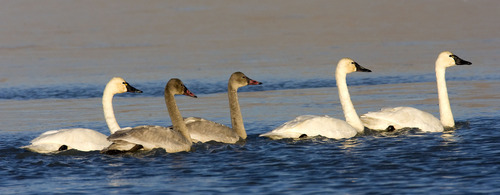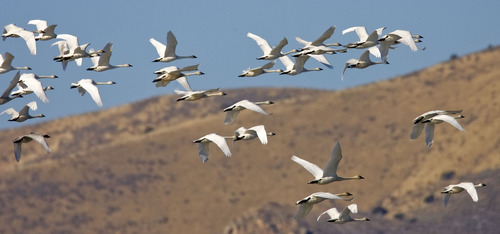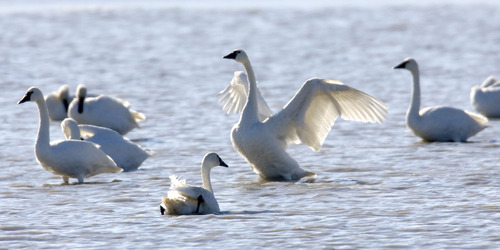This is an archived article that was published on sltrib.com in 2011, and information in the article may be outdated. It is provided only for personal research purposes and may not be reprinted.
The first time Sylvia Gray saw swans in Utah, she didn't even realize she was looking at a living creature — or creatures, as it turned out to be.
"I looked across the water, and I saw this huge ribbon of white. It looked like a snowbank, but it turned out to be tundra swans. Somebody estimated there were 10,000 of them," said Gray, an avid birder involved with the Great Salt Lake Audubon chapter of the National Audubon Society.
A huge influx of tundra swans makes its way through Utah twice each year as the massive birds (weighing roughly up to 25 pounds and sporting a 51/2-foot wing span) make their annual migration of more than 3,500 miles from the Arctic tundra to central California and back.
Wildlife officials with the Utah Division of Wildlife Resources (DWR) are charged with monitoring the number of swans migrating through Utah and have reported as many as 60,000 in big years. An average high is about 40,000.
Jason Jones, a wildlife biologist at Farmington Bay Waterfowl Management Area, said there were about 40,000 tundra swans in northern Utah during a count in mid-November. The birds will continue to filter through the state until mid-December. Some may even decide to winter in the Beehive State rather than head to California.
The return flight typically peaks in mid-March. The DWR holds an annual free viewing event the second Saturday of March to encourage people to head to the marsh and catch a glimpse of the swans on their way back to the Arctic.
Tundra Swan Day is held at Farmington Bay in the spring to avoid conflicts with the hunters. Gray said it is easier to find the birds in large numbers in the spring because they can get scattered by hunting pressure in the fall.
"They can be easily seen with the naked eye, but to see them with binoculars or a spotting scope is wonderful," Gray said. "They are big birds and very impressive. When you see them up close, you see how elegant they are. They can also be very vocal, and you can hear them chattering away from a long distance."
Birders enjoy seeing the swans, but hunting of tundra swans is also allowed.
Utah became the first state to allow legal hunting of tundra swans in 1962. There were 1,000 permits issued that year. Utah still provides the bulk of hunting permits for tundra swans with an annual allocation of 2,000. Hunting for the swans seems popular, as about 4,500 people enter their names in a drawing for the permits each year.
Hunters are required to take a swan orientation course. The course helps hunters, and birders, to tell the difference between the much more common tundra swan and the trumpeter swan.
Hunters who take a trumpeter swan will not get in any trouble, but if a certain number of the birds are confirmed shot each year officials will close the swan hunt.
"If we get more than 10 [in Utah], we will shut the season down," Jones said. "That hasn't ever happened though. We have made it to eight trumpeter swans."
Wildlife officials in Alaska and Canada manage to band some swans every year. It is easy to capture the birds when they are flightless during their annual molt. Catching them in Utah is a real chore, but Jones and Rich Hansen, manager of Farmington Bay Waterfowl Management Area, managed to catch 29 tundra swans in February 2008.
Nine of the banded have reportedly come back to Hansen since the birds were released. Six of the swans were taken by hunters (five in Utah and one in Montana). The others were sighted at two locations in California and at a refuge in North Dakota over the next two years.
Jones said interest from the general public in swans, and other waterfowl and shore birds in general, has grown in recent years and is easily much greater than interest from hunters. A survey at Farmington Bay showed that of the annual visitation of 100,000 to the area, only 30 percent were people actively hunting.
Gray said the idea that the swans were being killed was troubling, but she recognized that the population is not in any danger.
"Yes, it does bother me because they are not destructive to the environment like, say, snow geese, but I understand the hunting concept," she said. "There are, however, plenty of other birds that provide that opportunity."
Swans in Utah
Utah experiences an annual migration of about 40,000 tundra swans each fall and spring. The birds fly through on their way to central California, where they winter, and then on the way back to the Arctic tundra. Trumpeter swans, a much more rare swan, are also found in Utah in the winter. Hunters and birders can learn to tell the difference by taking an online orientation course at http://www.utah-hunt.com/utswancourse
Source: Utah Division of Wildlife Resources





























